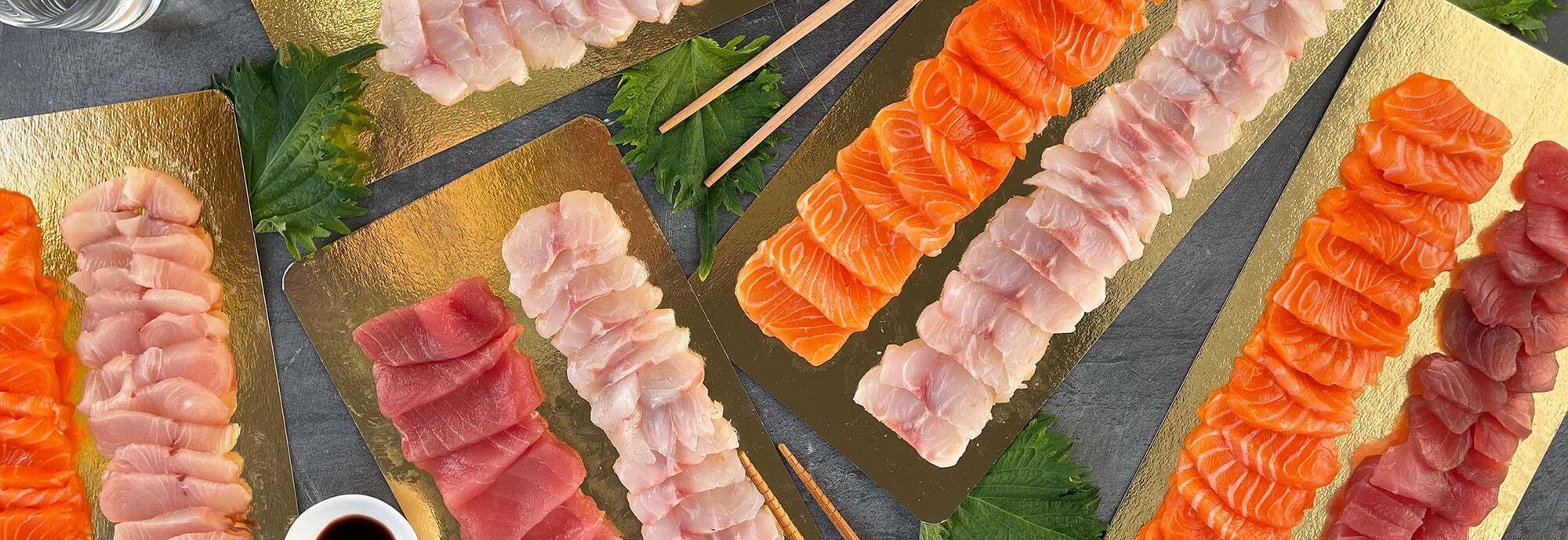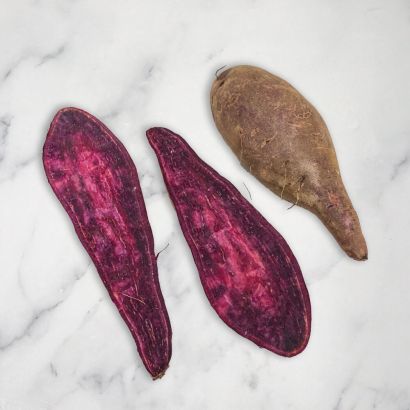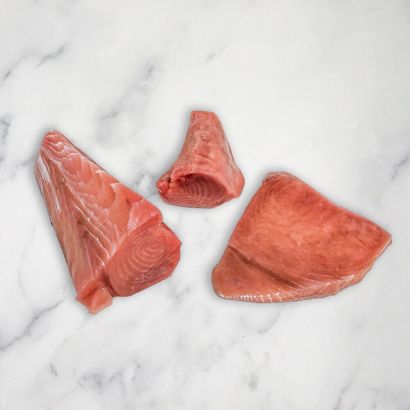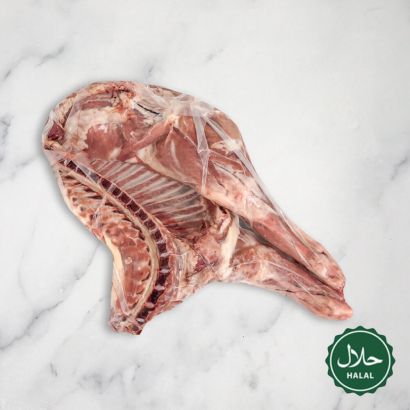At Fine Food Specialist, we take pride in offering an exquisite selection of sashimi, including premium varieties such as Bluefin and Yellowfin tuna, succulent salmon, delicate Hiramasa, flavourful Sea Trout and tender Sea Bass. Our commitment to quality ensures that each slice of sashimi delivers unparalleled freshness and flavour, perfect for sushi enthusiasts and seafood lovers alike. Whether you're hosting a special occasion or simply craving the finest sashimi experience, Fine Food Specialist is your ultimate destination for premium seafood delights. Explore our collection today and indulge in the exceptional taste of our carefully sourced sashimi selections.
What is Japanese Sashimi?
Sashimi is a traditional Japanese dish consisting of thinly sliced raw fish or seafood that is typically served as an appetiser or part of a formal meal: Japanese raw fish. The word 'sashimi' translates to 'pierced body', referring to the technique of slicing the fish thinly and serving it without any cooking.
Sashimi is often served with soy sauce for dipping, as well as wasabi (Japanese horseradish) and pickled ginger (gari) on the side. The dish is appreciated for its fresh, clean flavours and delicate textures, allowing the natural taste of the fish to shine.
Sashimi is a staple of Japanese cuisine and is often enjoyed alongside sushi, rice and other accompaniments as part of a traditional Japanese meal. It is also celebrated for its aesthetic presentation, with the slices of fish arranged carefully on a plate to showcase their colours and textures.
What is Sashimi Grade Seafood?
Sashimi grade seafood refers to seafood that is of the highest quality and freshness, making it safe and suitable for raw consumption, particularly in dishes like sashimi and sushi. The term 'sashimi grade' is not a regulated designation, but it generally indicates that the seafood and shellfish have been handled and prepared in a specific way to minimise the risk of foodborne illnesses.
Key characteristics of sashimi grade seafood include:
- Freshness: Sashimi grade seafood is typically extremely fresh, often sourced from reputable suppliers who prioritise quality and safety.
- Handling: Proper handling techniques are crucial in maintaining the freshness and safety of sashimi grade seafood. This may include rapid chilling or fast freezing to -60°C to kill any potential parasites or bacteria.
- Texture and Flavour: Sashimi grade seafood should have a firm texture and clean, fresh flavour, making it ideal for raw consumption.
- Appearance: The appearance of sashimi grade seafood should be pristine, with vibrant colours and no signs of discolouration, off-odours or other defects.
It's important to note that not all seafood is suitable for raw consumption, as certain types of fish may contain parasites or bacteria that can cause illness if not properly handled or prepared. Therefore, when purchasing seafood for raw consumption, it's recommended to buy from reputable suppliers like Fine Food Specialist who specialises in sashimi grade products and adhere to strict quality and safety standards. Additionally, following proper storage and handling guidelines at home is essential to ensure the safety of raw seafood dishes.
Types of Sashimi Grade Seafood & Shellfish
There is a wide variety of seafood and shellfish that are commonly considered sashimi grade, meaning they are safe and suitable for raw consumption. Some of the most popular types include:
- Tuna Sashimi: Bluefin, Yellowfin and Bigeye tuna are commonly used for sashimi due to their firm texture and rich flavour.
- Salmon Sashimi: Wild-caught salmon, particularly sockeye and king salmon, is prized for its buttery texture and delicate flavour when served raw.
- Yellowtail (Hamachi) Sashimi: Yellowtail has a rich, buttery flavour and firm texture that makes it ideal for sashimi and sushi.
- Sea Bass Sashimi: Sea Bass, known for its mild flavour and delicate texture, is a popular choice for sashimi.
- Snapper Sashimi: Red snapper and other varieties of snapper are often used for sashimi due to their firm texture and sweet, clean flavour.
- Mackerel Sashimi: Mackerel is appreciated for its bold flavour and firm flesh, making it a popular choice for sashimi and sushi.
- Scallop Sashimi: Fresh scallops, when sliced thinly, have a sweet and delicate flavour that pairs well with citrusy marinades.
- Prawn Sashimi: Large, high-quality shrimp, such as tiger shrimp or spot prawns, can be served raw as sashimi when very fresh.
- Crab Sashimi: Certain types of crab, such as snow crab or king crab, offer sweet and tender meat that is delicious when served raw.
- Lobster Sashimi: Lobster tail meat, when extremely fresh, can be enjoyed raw as sashimi, offering a sweet and succulent flavour.
- Oysters Sashimi: Fresh oysters are often served raw as sashimi, showcasing their briny flavour and delicate texture.
Types of Sashimi Grade Fish
Sashimi fish is a term used to describe fish that meets specific quality and safety standards, making it suitable for raw consumption in dishes like sashimi and sushi. Common types of fish that are considered sashimi grade include:
- Tuna (such as Bluefin, Yellowfin, and Bigeye)
- Salmon (typically wild-caught or from reputable farms)
- Hamachi (Yellowtail)
- Sea Bass
- Snapper
- Mackeral
- Striped Bass
- Flounder
It's important to note that the quality and safety of sashimi seafood, sashimi shellfish and sashimi fish depend on factors such as freshness, handling and proper storage. When purchasing seafood for raw consumption, it's essential to buy from reputable suppliers who specialize in sashimi-grade products and adhere to strict quality and safety standards. Additionally, following proper storage and handling guidelines at home is crucial to ensure the safety of raw seafood dishes.
Is Sashimi Sushi?
While sashimi and sushi are both popular Japanese dishes that often feature raw fish, they are not the same.
Sashimi refers specifically to thinly sliced raw fish or seafood that is served without rice. It is typically enjoyed with soy sauce, wasabi and pickled ginger on the side. Sashimi showcases the natural flavours and textures of the fish, with each slice carefully prepared to highlight its freshness and quality.
Sushi, on the other hand, is a broader term that refers to any dish made with vinegared rice combined with various ingredients, which can include raw or cooked fish, seafood, vegetables and other toppings. While some types of sushi do include raw fish, such as nigiri sushi (a small mound of rice topped with fish or seafood), others may feature cooked ingredients or even no fish at all.
In summary, while sashimi is a type of sushi, not all sushi includes sashimi. Sashimi specifically refers to the sliced raw fish component of sushi, while sushi encompasses a broader range of dishes that feature vinegared rice as a base.
Is Sashimi Healthy?
Sashimi can be a healthy food choice when consumed as part of a balanced diet. Here are some reasons why sashimi can be considered healthy:
- High in Protein: Sashimi is a rich source of high-quality protein, which is essential for muscle repair and growth, as well as overall health and well-being.
- Low in Calories: Sashimi is generally low in calories, particularly when compared to other types of protein-rich foods. This can make it a suitable option for those looking to manage their calorie intake or maintain a healthy weight.
- Rich in Omega-3 Fatty Acids: Many types of fish used in sashimi, such as sashimi salmon and sashimi grade tuna, are rich in omega-3 fatty acids, which have been linked to numerous health benefits, including reduced risk of heart disease and improved brain function.
- Source of Essential Nutrients: Sashimi is a good source of essential nutrients such as vitamins, minerals and antioxidants, depending on the type of fish or seafood used. These nutrients play important roles in various bodily functions and contribute to overall health.
- Low in Saturated Fat: Sashimi is typically low in saturated fat, which is known to increase the risk of heart disease when consumed in excess. Choosing lean sources of protein like sashimi can help promote heart health.
However, it's important to note that the healthiness of sashimi can depend on various factors, including the type of fish or seafood used, how it is prepared and any additional ingredients or condiments served with it. Additionally, pregnant women, young children and individuals with compromised immune systems should take caution when consuming raw fish due to the risk of foodborne illnesses. Overall, sashimi can be part of a healthy diet when enjoyed in moderation and as part of a balanced eating plan.
Calories Sashimi Salmon
The number of calories in sashimi salmon can vary depending on factors such as the size of the serving and the specific preparation method. However, as a general guideline, here are approximate calorie counts for typical servings of sashimi salmon:
- 3 ounces (85 grams) of raw salmon sashimi: Approximately 120-150 calories
- 6 pieces of nigiri sushi (with raw salmon on rice): Approximately 250-300 calories
These calorie counts are based on raw salmon alone and do not include any additional ingredients, sauces or condiments that may be served with the sashimi. It's important to keep in mind that while salmon is a nutritious food rich in protein and healthy fats, the total calorie count can increase significantly if the sashimi is served with rice or high-calorie sauces.
If you're watching your calorie intake, it's a good idea to be mindful of portion sizes and any added ingredients when enjoying sashimi grade salmon. Additionally, consider pairing your sashimi with low-calorie condiments like wasabi or soy sauce in moderation to help control overall calorie intake.
Sashimi Platter to Buy Online
Fine Food Specialist is known for curating premium-quality ingredients and our sashimi platters feature top-grade fish and seafood sourced from reputable suppliers. Our platters include a selection of different types of fish commonly used in sashimi, such as salmon, tuna (Bluefin, Yellowfin), yellowtail (hamachi), mackerel and more. Each type of fish may offer a unique flavour and texture experience:
- Bluefin Tuna 'Otoro' Sashimi Platter
- Bluefin Tuna 'Akami' & Salmon Sashimi Platter
- Handcut Salmon & Hiramasa Sashimi Platter
- Handcut Yellowfin Tuna & Sea Bass Sashimi Platter
- Handcut Salmon & Sea Bass Sashimi Platter
Buy Sashimi UK
Here at Fine Food Specialist, we offer an exquisite selection of sashimi, providing customers in the UK, including London, with premium-quality fish for their culinary adventures. With a convenient online platform, customers can easily buy sashimi grade fish, including salmon sashimi, from the comfort of their own homes.
Whether you're looking for traditional sashimi favourites or exploring new flavours, Fine Food Specialist is your trusted destination for purchasing sashimi online in the UK. Indulge in the freshest sashimi fish sourced from reputable suppliers and elevate your dining experience with our carefully curated selection. Discover where to buy sashimi grade fish and order your salmon sashimi online today, exclusively from Fine Food Specialist.






